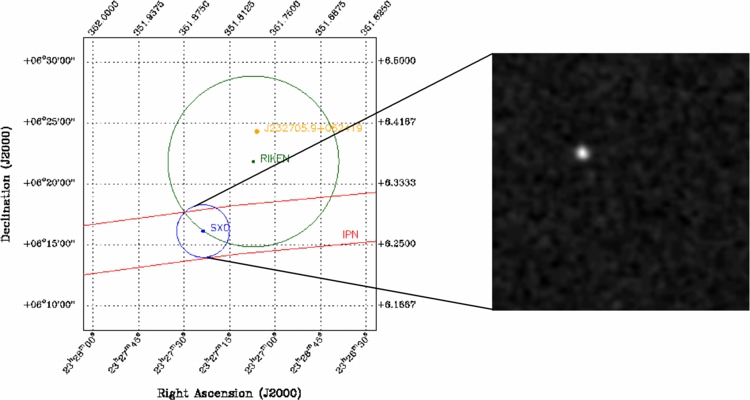
 Credit: R. Vanderspek (MIT) & the HETE-2 team; K. Hurley (Berkeley)
Credit: R. Vanderspek (MIT) & the HETE-2 team; K. Hurley (Berkeley)
Chasing the Wild Burst
Gamma ray bursts (GRBs) are among the most powerful and mysterious events in the universe. They release tremendous amounts of energy, but since they only last a few seconds or few minutes, and since gamma-ray telescopes have poor spatial resolution, the counterparts of these bursts have been difficult to identify. A technique which has proved successful is to image the X-ray afterglows (which seem to accompany the bursts, and last much longer) using the better spatial resolving power of X-ray telescopes. A small satellite observatory called the High Energy Transient Explorer 2 (or HETE-2 for short) has been trying to use this technique to identify bursts, using a matched set of X-ray and Gamma ray telescopes. The map on the upper left shows the X-ray error circles for a burst which occurred on August 19, 2002. The large error circle is from the Wide Field X-ray Monitor (or WXM) on HETE-2, while the smaller error circle is from HETE-2's Soft X-ray Camera (or SXC). The annulus in red is the localization of the burst position using the set of satellites which make up the Interplanetary Network; gratifyingly, the SXC error circle agrees well with the IPN annulus. The field on the left shows the Digitized Sky Survey image of the SXC field from Skyview; no optical counterpart has yet been identified for this burst.
Last Week *
HEA Dictionary * Archive
* Search HEAPOW
* Education
Each week the HEASARC
brings you new, exciting and beautiful images from X-ray and Gamma ray
astronomy. Check back each week and be sure to check out the HEAPOW archive!
Page Author: Dr. Michael F. Corcoran
Last modified €


